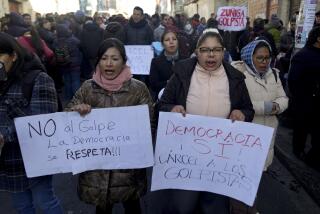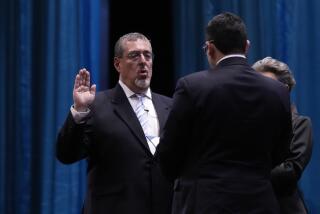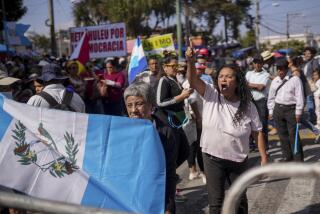Maverick Governorâs Defiance a Test of Aquinoâs Power and Resolve : Philippines: He refused for weeks to accept suspension for backing a coup attempt and tied the system in knots before finally stepping down.
TUGUEGARAO, Philippines â Bonfires of burning tires lit the night sky, and scowling guards armed with assault rifles checked everyone who entered Rodolfo Aguinaldoâs bunker-like concrete command center--surrounded by a 12-foot-high barbed wire fence.
Inside, President Corazon Aquinoâs latest nightmare was holding court.
âIâm a pain in the everything,â Aguinaldo told visitors with a grin. âIn Manila, they get constipated every time they think of me.â
Indeed, six weeks after Aguinaldo donned combat fatigues and announced that he had sent troops and tanks to Manila to join an attempted coup by mutinous soldiers, the boyish-faced governor and political boss of rugged Cagayan province tied Aquinoâs government in knots.
For 16 days, Aquino tried to enforce a government order suspending Aguinaldo from office for supporting the coup. For 16 days, Aguinaldo refused, becoming an embarrassing public symbol of Aquinoâs political impotence.
By the time Aguinaldo finally stepped down last Saturday, two days after the interview in his command center, his defiance was daily headline news. How Aguinaldo resisted tells a lot about how the Philippines works. It tells even more, perhaps about why Aquinoâs government often doesnât work.
Aguinaldo is one of the Philippinesâ classic warlords, a former national police intelligence commander who became infamous under deposed President Ferdinand E. Marcos. Known as a fierce anti-Communist, he trained and led a private âblack armyâ of several hundred 4-foot-tall Negrito tribesmen and former Communist commandos.
Their tactics were not subtle: Amnesty International accused him repeatedly in the mid-1980s of torturing, maiming and murdering his foes. A church group accused him of raping the wives, sisters and daughters of his prisoners. Other human rights groups called him Marcosâ top torturer.
Aguinaldo was also one of the early leaders of RAM, the Reform the Armed Forces Movement. The âRamboysâ have figured in every one of the six attempted coups against Aquino, and Aguinaldo has never kept his sympathies secret.
In August, 1987, for example, while still provincial police commander in Cagayan province, he won national notoriety by flying the Philippine flag upside down to symbolize his support for an abortive coup by RAM leader Col. Gregorio (Gringo) Honasan. Aguinaldo held out for months as head of one of the so-called âlost commandsâ before resigning to run for governor. He won in January, 1988, in a landslide. Since then, his critics say, he has used his army and political payoffs to run a $50,000-a-day local lottery, as well as a lucrative illegal logging and smuggling operation in one of the nationâs poorest provinces.
Aguinaldoâs critics include 17 of the provinceâs 29 mayors. They met Aquino in Manila to demand his ouster for treason and corruption.
âHe is destroying the province,â Delfin Ting, mayor of Tuguegarao, the provincial capital, said before Aguinaldo ended his defiance.
Indicating his own armed bodyguards, Ting added, âWhat we are worried about now is assassination attempts against mayors.â
Aguinaldo and his supporters, in turn, accuse the local mayors, congressmen and other politicians of drug abuse, illegal gambling, smuggling and more.
âHeâs fighting to eliminate all graft and corruption in the province,â said Ferdinand Trinidad, vice mayor of Iguig and one of hundreds of Aguinaldoâs supporters who gather daily at the governorâs compound. âThe others are trying to protect their interests.â
âThe governor is a phenomenon,â agreed Felito Ramirez, a member of the provincial board. âHe is adored by the masses and hated by the elite.â
But the long-festering local fight over provincial spoils 250 miles north of Manila spilled into the national arena after Aguinaldo went on radio and telephoned foreign news bureaus, including that of The Times, during the Dec. 1-9 coup attempt. He said he had sent 5,000 armed troops, plus tanks and artillery down to Manila.
The troops, who apparently numbered closer to 50, were turned back at an army barricade on a winding mountain road about 100 miles south of here, according to military officials. Ever since, Aguinaldo has denied talking to reporters or sending the troops.
âThey have to prove it in court,â he said. âHow can they prove it?â
Aguinaldo has used the courts to fight Manila, filing motions and getting a local judge to restrain Aquinoâs 60-day suspension order. When the nationâs Supreme Court overturned the local judge, Aguinaldo said the government needed a new court order to break through barricades outside his compound.
Repeated visits and phone calls by Aquino aides, including Defense Secretary Fidel V. Ramos, failed to resolve the crisis. Deadlines came and went. Daily headlines rubbed salt in Aquinoâs wounds.
âHeâs making a fool out of the government,â complained Ramon V. Mitra, speaker of the House of Representatives.
The standoff produced the kind of theater that passes for politics here. In meetings and rallies, Aguinaldo strutted and shouted, saying alternately that he would wage âtotal war,â go underground, or submit to the âwill of the people.â
âThe voice of the people is the voice of God,â he shouted to his cheering supporters.
Hundreds of Aguinaldoâs supporters jammed the local airport last week to block a plane bringing his replacement, Vice Gov. Melvin Vargas. Hundreds more barricaded themselves into Aguinaldoâs compound. The more fervent fans said they were willing to die to keep him in office.
But 100 riot police from Manila and a single tear-gas shell sent the supporters scampering last Saturday. Vargas took the oath as acting governor and immediately denied allegations of corruption. And Aguinaldo retreated to his bunker while his lawyers went back to court.
âIâm just using the law to defend myself,â he said Monday by phone. âPlus, Iâm waiting for them to drag me away.â
More to Read
Sign up for Essential California
The most important California stories and recommendations in your inbox every morning.
You may occasionally receive promotional content from the Los Angeles Times.











